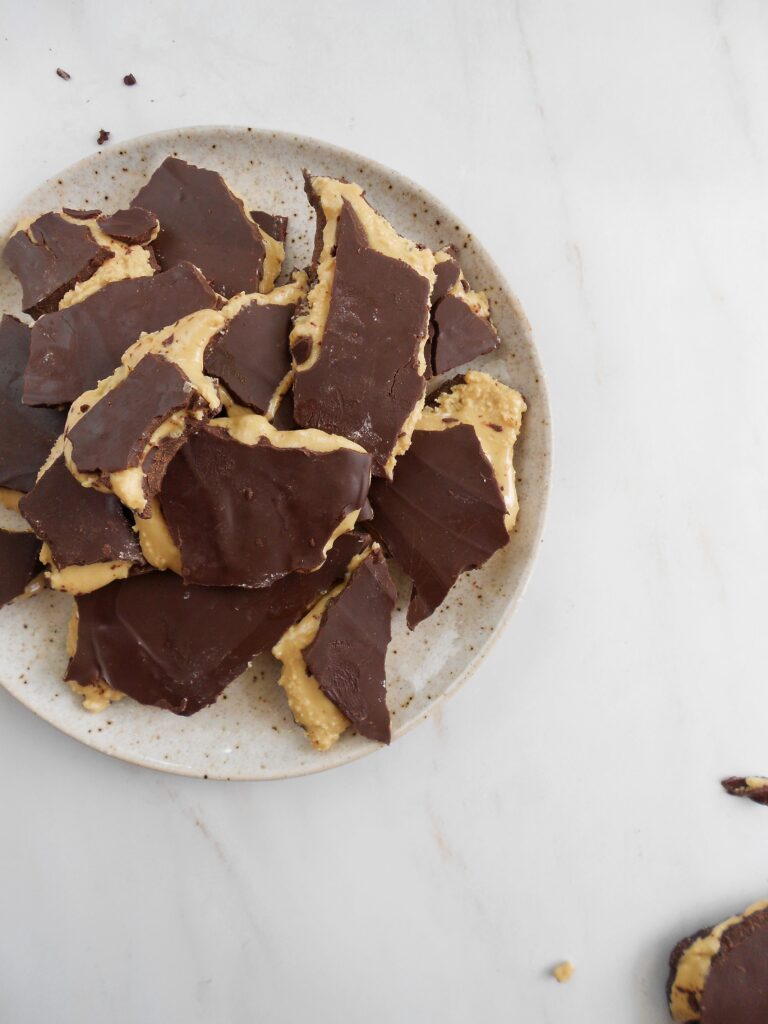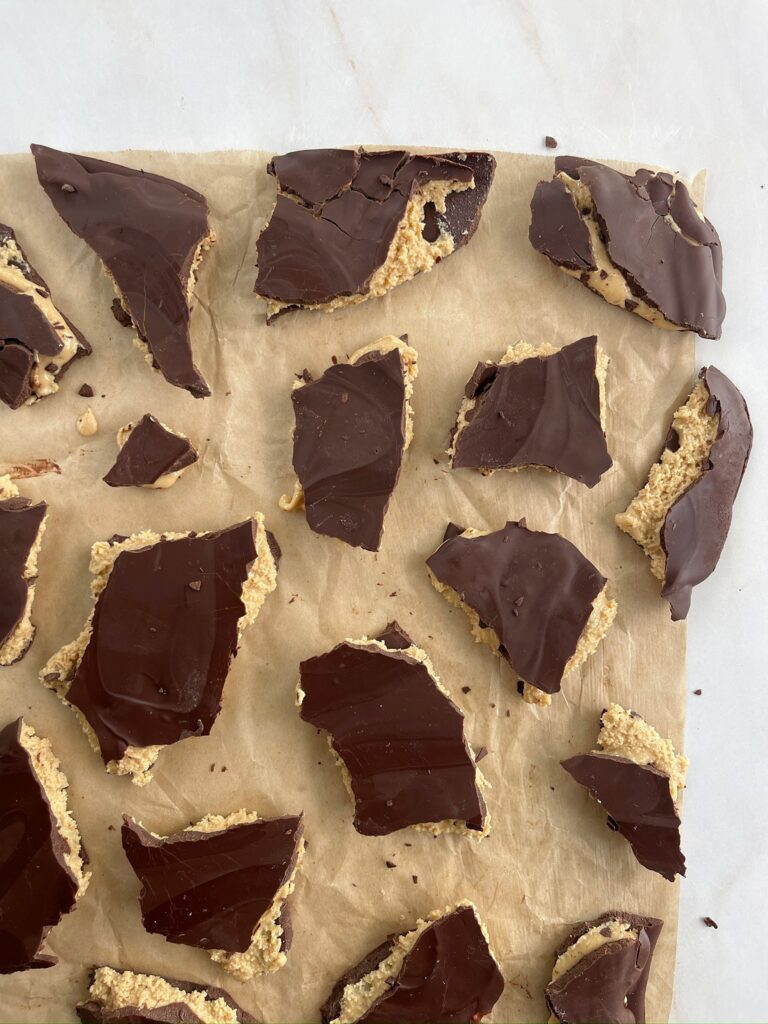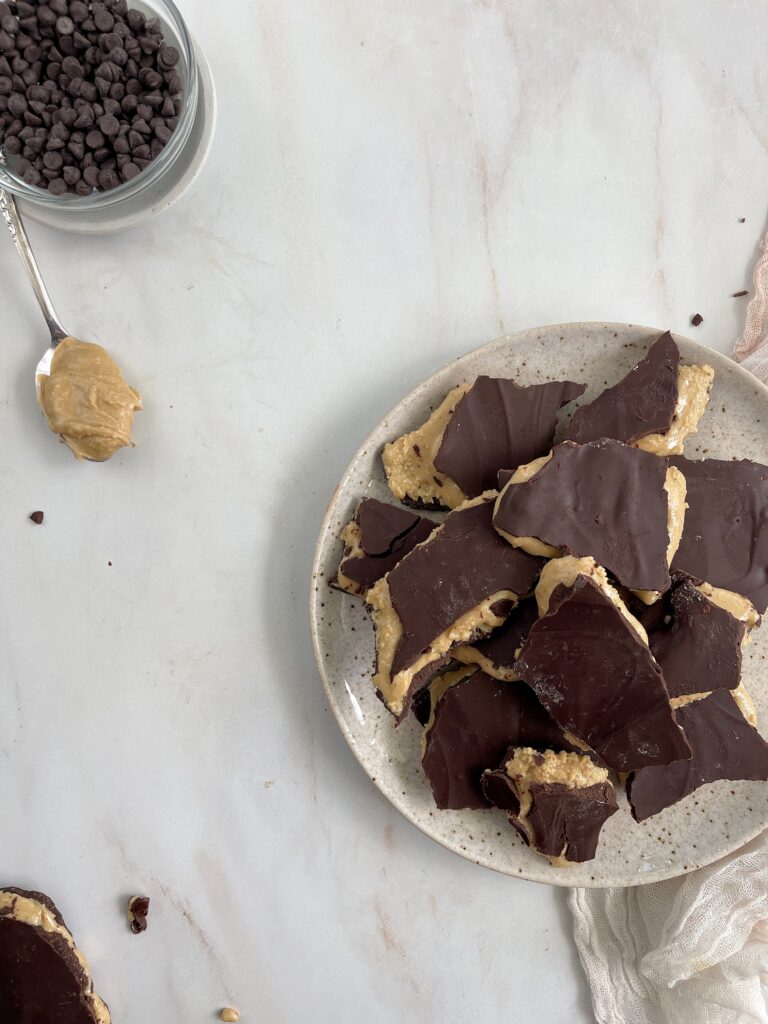Peppermint bark meets buckeyes.




You know how tedious and repetitive of an ordeal buckeyes are if you’ve ever made them.
If you haven’t, imagine this: getting the peanut butter mixture together, scooping and rolling that into dozens of bite-sized balls, spacing those out onto a lined pan, putting the pan in the fridge, melting the chocolate, and then poking each ball with a toothpick to dip in the pot of chocolate and transferring back to the pan while trying not to leave a trail of melted chocolate behind – or too big of one at least. Partway through the process, you might need to hit pause so you can pop the pan back into the fridge because the peanut butter balls have softened too much, which makes dipping a nightmarish mess. Once the dipping is done, it’s time to go back and smooth over each and every hole leftover from the toothpick (which isn’t totally necessary, but it makes them look nice and more like actual buckeyes). And then at last, you’re finally done!
Yet if you’ve had a buckeye, you know how indescribably next-level – borderline otherworldly, really – they are.
The way the textures of the sweet peanut butter and soft, sink-your-teeth-in chocolate fuse together to melt in your mouth while making your taste buds tingle and dance in delight makes them worth the work, though. (Not to mention highly addictive!)
But humans being, well, humans and wanting to have their cake and eat it too, are always on the lookout for shortcuts.
And that’s where this recipe comes in; you don’t have to put all that time and effort into making traditional buckeyes. Now you can have the same iconic, irresistibly indulgent taste and texture of buckeyes WITHOUT the work!

Buckeye Bark
Ingredients
- 18 oz. chocolate, divided* dairy-free
- 4 tsp. oil, divided: walnut, almond, coconut, or other neutral flavored oil
- 9 oz. creamy peanut butter*
- 2 TBSP powdered sugar*
- 2 TBSP powdered monk fruit, stevia, or other sweetener* homemade or store-bought
Instructions
- Line a baking dish or cookie sheet with parchment or wax paper; have some excess hanging over the sides, it will help later when breaking up the bark
- Add half of the chocolate (9 oz.) and half of the oil (2 tsp.) into a microwave-safe bowl and melt in 15-25 second increments in the microwave, stirring thoroughly between so the chocolate doesn't burn
- Line a baking sheet or casserole dish with parchment or wax paper, and pour the melted chocolate in and spread it out evenly with a rubber spatula or knife*
- Place the pan in the fridge for the chocolate to set, and prepare the peanut butter mixture while waiting
- In a bowl, combine the peanut butter, powdered sugar, and powdered stevia (in a blender or food processor, blend the stevia or other sweetener up to a fine dust) and mix them together – it'll be thick, so continue to fold and press the peanut butter with a rubber spatula until there are no more clumps of sugar
- Once the peanut butter mixture is prepared, disperse it as evenly as possible – it doesn't have to be perfect – over the chocolate by forming thin patties (no more than ¼" thick) by hand and layering them on top of the chocolate or pressing and spreading it with a rubber spatula*
- Return the pan to the fridge and melt the remaining chocolate and oil, same as in step 2
- Pour the melted chocolate on top of the peanut butter layer and use a rubber spatula or knife to spread it out evenly, covering the peanut butter entirely, then place the pan back in the fridge
- Once the top layer of chocolate is set, use the excess paper hanging over the sides as "gloves" to break the bark up into pieces by hand – using the paper is far less messy as the chocolate won't start to melt in your hands
- Store in the fridge (and be tantalized every time you open the fridge); it's soft enough to eat straight from the fridge, but you can let it sit at room temperature for a few minutes to let it soften even more before eating if you prefer
Notes
- *Chocolate: Enjoy Life is an allergen-friendly brand that bakes, melts, and tastes like regular chocolate and is what was used here
- *Peanut butter: thicker, non-runny peanut butter works best (the freshly ground peanut butter that you can grind in the store is usually nice and thick)
- *Powdered sweetener: you can quickly make your own powdered sweetener by blending up stevia or another sweetener of choice until it’s a fine powder
- *Powdered sugar: you can use all powdered sweetener in place of the powdered sugar to cut down on added sugar; so 4 TBSP of powdered sweetener and no powdered sugar, or the opposite – all powdered sugar if y0u prefer (doing so would increase the sugar content of the recipe, if that’s something you’re conscientious of)
- *3. The size of the pan or dish isn’t super important (typically a standard, medium sized pan anywhere from ~10-15″x13-18″ is used, but whatever you have will surely work) – the smaller the pan, the thicker the bark will be, and it’ll get thinner and make more bark the larger the pan is, but that’s the only aspect of the recipe impacted by the size of the pan
- *6. As long as your peanut butter isn’t runny, adding the peanut butter layer by hand is the preferred method; it’s not as gooey or messy as you may think, and it prevents the possibility of pressing the PB too forcefully though the chocolate if it hasn’t fully set or cracking the chocolate layer altogether. If you don’t do it by hand, warm the peanut butter mixture in the microwave first to make it a little more spreadable and work carefully. If your peanut butter is on the runnier side, spreading it with a rubber spatula, butter knife, or spoon will work best.
- To make this vegan, ensure the powdered sugar is free from bone char and other animal-derived ingredients
Even though buckeyes are worth it, sometimes you just want the buckeyes without all the work. This recipe is for those times. And my oh my, is it one for the (recipe) books! You don’t have to take my word for it though:
- “This is a sin”
- “You should patent this stuff and sell it in grocery stores”
- “I don’t know what’s better, the chocolate or the peanut butter”
- “I think that’s one of my favorites!!”
- “Better than Reese’s”
- “It’s really addictive …it’s kind of a problem actually”
Those are just some snippets of what my family had to say about the buckeye bark as they were (very happily) serving as my taste testers for this recipe!
And what makes this version of buckeyes even better is that they’re dairy-free, gluten-free, and made with minimal, more natural ingredients!
For another SUPER easy peanut butter recipe: One Bowl Peanut Butter Cookies
And for the PB + chocolate combo lovers: PB Nutella Bars




If interested, the macronutrients are below. They are kept separate at the very end of each recipe blog so that this can remain a safe, positive space for all as not everyone wishes to see the nutritional information.
Macros for the whole recipe: 377.9 C | 315.7 F | 97.2 P
Similar to the Chocolate Pecan Pie Fudge, sometimes what makes a recipe healthier isn’t the numerical values measured in macronutrients, but the quality and quantity of the ingredients. A traditional buckeye recipe, for example, calls for 1 pound of powdered sugar and 1 stick of butter, if not more. Compare that to this recipe which contains 2 tablespoons of powdered sugar and 4 teaspoons of oil, a better, less inflammatory source of fat than butter. To put that into perspective, one pound of powdered sugar is about 56 tablespoons and 1 stick of butter equates to 24 teaspoons.
Keep in mind that this is for the entire pan of buckeye bark as well; while you may want to and feel like you can eat the whole tray in one sitting, you likely will only have a small fraction. And what’s most important is not the numbers or how they fit into your macros, but that you enjoy what you eat without being preoccupied with finagling an indulgent treat that you don’t have every day into your daily macros.
The macros for recipes are also available on MyFitnessPal. Simply search the name of the recipe followed by “ – SUNutrition” (so for this recipe, search “Buckeye Bark – SUNutrition”).

leave a comment